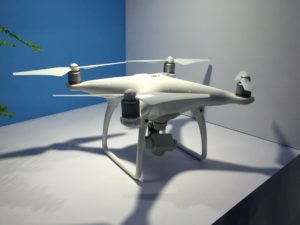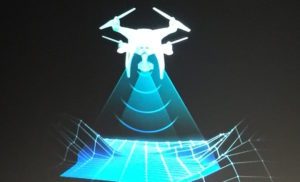 If you are looking to get into drones but have so far been turned off by how technologically complex they are, the DJI Phantom 4 may be the answer you are looking for, provided you are willing to pay for it.
If you are looking to get into drones but have so far been turned off by how technologically complex they are, the DJI Phantom 4 may be the answer you are looking for, provided you are willing to pay for it.
Rumors had been swirling for several weeks, the price of Phantom 3s was dropping at most major online retailers and many, including the DroneLife staff, had been speculating about what DJI would bring to the table when the new drone was officially announced. By far the most discussed issue we saw ahead of the announcement was barrier to entry – it’s easy to buy a Phantom and hover, but it takes many hours to become a competent enough flier to take pictures or shoot video worth taking. Personally, as someone who has been watching this industry for many years now, I believed the one feature DJI needed to bring to the Phantom was sense and avoid.
With the Phantom 4, DJI has delivered on all accounts.
For starters, the DJI Phantom 4 nearly features an all new way to pilot the drone called Fly with Tap… which is an apt name for the function of pairing the Phantom with a phone or tablet to get a live feed of what the camera sees then tapping the direction you want to fly. This makes taking aerial video easier than ever because the camera is driving the shot instead of the twin control sticks.
Instead of making tons of tiny micro-compensations that can result in choppy video, the result is a smooth shot driven by the drone itself.
Laid on top of Fly with Tap is ActiveTrack, which takes the traditional concept of Follow Me and turns it up to eleven. Instead of requiring a phone or a WiFi tether to follow, the Phantom 4 uses it’s visual sensors and a complex computer vision algorithm to lock onto a subject and track it, in three dimensions, as it moves through space.
And all you have to do is tap a subject on the live stream displayed on your live stream. The most impressive part of the ActiveTrack feature, which gives the Phantom 4 the ability to stay locked on to a subject it is following even when more moving subjects enter the drone’s field of view. This feature was demonstrated at the announcement event on Tuesday in New York by having a rollerblader circle a runner who was being followed by the Phantom 4.
The Fly with Tap and the ActiveTrack make controlling the Phantom easier than ever by essentially taking a certain amount of piloting control out of the hands of the pilot.
If that sounds like a lot of added responsibility given over to the Phantom itself, you’re paying attention! It absolutely is!
 But that’s where the most important and hopefully standard-setting new feature comes in: the sense and avoid.The ability of a Phantom to perceive and navigating around obstacles isn’t exactly a new one, but the Phantom 4 marks the first time such a feature has been brought to market already built in to a UAV.
But that’s where the most important and hopefully standard-setting new feature comes in: the sense and avoid.The ability of a Phantom to perceive and navigating around obstacles isn’t exactly a new one, but the Phantom 4 marks the first time such a feature has been brought to market already built in to a UAV.
DJI added two optical sensors to the front of the Phantom 4 and an extra downward facing camera so the Phantom can “see” up to 50 feet in front and 33 feet below itself. That means there is essentially a sphere around the Phantom 4 in which the drone knows exactly what (or who) is near it. When the Phantom 4 comes within six feet of an object, it decides if it should go over the object, around it, or simply stop and await instructions.
The most common road bump in a new drone user’s experience usually has to do with a swift and unintentional introduction between their Phantom and the side of their house.So this extra safety net could both encourage new pilots, who have been interested but intimidated, to finally pick up their first drone and keep first timers in the air longer.
And speaking of staying in the air longer, the Phantom 4 also has a brand new (lighter battery) which allows for an industry first 28 minutes of flight time on a single charge.
Other new features on the Phantom 4 include raised motors for faster cooling, push and lock propellers, a new, lighter gimbal, a sleeker body design to reduce drag, a pause button on the controller that will immediately stop any automated flight path, and a new Sport Mode wherein the Phantom get clock speeds up to 45 mph!
The only thing that would deter someone from joining the drone revolution with a Phantom 4 is the price tag – The Phantom 4 might be DJI’s most advanced drone yet but it also comes with the most expensive price so far. $1,399 is a lot to ask first time buyers, even if they are more likely not to crash.
The DJI Phantom 4 is available for preorder now and first shipments will begin on March 13. For the first time, you can actually buy a Phantom in-store at, (of course) Apple stores around the country. All other major online retailers will begin shipping on April, 1.
What do you think? Have you already preorder a Phantom 4? Let us know in the comments!
Alan is serial entrepreneur, active angel investor, and a drone enthusiast. He co-founded DRONELIFE.com to address the emerging commercial market for drones and drone technology. Prior to DRONELIFE.com, Alan co-founded Where.com, ThinkingScreen Media, and Nurse.com. Recently, Alan has co-founded Crowditz.com, a leader in Equity Crowdfunding Data, Analytics, and Insights. Alan can be reached at alan(at)dronelife.com







Sense and avoid can’t be the cheapest thing to buy on any drone so an extra $150 doesn’t seem that steep. It has taken a while for DJI to adopt the technology though so that might not sit well with some buyers. My initial concern is the system is still in its infancy so I am assuming you can turn the sense and avoid off when careening along at 45 mph that is a pretty good clip! Doesn’t seem possible for sense and avoid to work satisfactorily at 45 mph yet. Still the author is excited with good reason the automation will get a lot of newbies out of tight situations where they likely would pile into a tree or perhaps worse. Look at this as cheap insurance, but carry insurance anyways. If I can pony the pennies I’ll be buying one of these puppies. Very good value perhaps unbeatable for now. Thanks to author for explaining all the new improvements been holding off but I doubt much longer this drone is darn near good proof.